Instrumentation
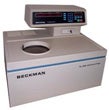
The Beckman Optima TL Ultracentrifuge is an ultracentrifuge with features that include thermoelectric refrigeration, microprocessor control, very smooth acceleration/ deceleration profiles, air cooled, imbalance tolerant drive, fast instrument set-up and diagnostic displays. This system can store up to 10 user programs, can reach speeds of 100,000 rpm and can generate a force of 543,000 x g max.
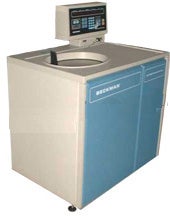
The Beckman L8-70M Ultracentrifuge has been the mainstay of laboratories world-wide for ultra high speed centrifugation processes. The ultracentrifuge can operate at much higher speeds and allows for the faster separation of samples. Some example applications include: sucrose gradient isolation of proteins, density gradient fractionation of lipoproteins, fractionating subcellular components (nucleosomes, microsomes, mitochondria, etc.), plasmid purification in CsCl, and RNA pelleting in CsCl. Two rotors are available: (1) Type 45 Ti: 6 x 94 mL samples, max speed 45,000 rpm (235,000 x g) or (2) Type 70 Ti: 8 x 39 mL samples, 70,000 rpm (504,000 x g).
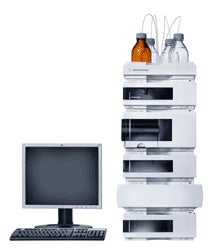
The Agilent 1200 HPLC series can separate a mixture of compounds and is used in biochemistry and analytical chemistry to identify, quantify and purify the individual components of the mixture. This HPLC is a preparative autosampler designed to perform preparative LC. It allows injection of sample volumes from µL to mL ranges from vials.
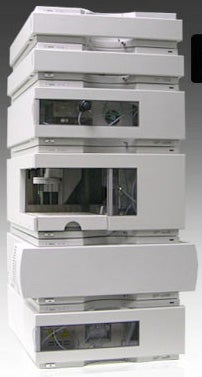
The Agilent 1100 HPLC is a stand-alone system that supports both ultraviolet and fluorescence detection. The HPLC pump is a binary system capable of up to a 10 ml/min flow rate and 400 bar of pressure. The UV-vis detector is a diode array, with a wavelength range from 190 – 950 nm. The fluorescence detector provides simultaneous quantitative and qualitative information for up to four signals simultaneously. The system also incorporates a mobile phase degasser, column heater, and 100 vial autosampler. Data acquisition and analysis is performed using ChemStation software.
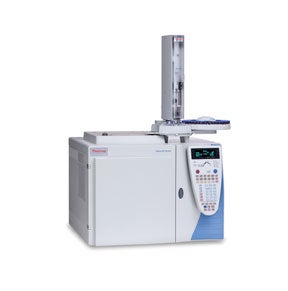
The Thermo Scientific TRACE GC Ultra multi-channel gas chromatograph was developed for the evolving requirements of modern laboratories. With the most complete range of proprietary inlets, sensitive detection systems, smart accessories, and ancillary devices, the Ultra platform features unique technologies that raise the standards of speed, sensitivity and separation in gas chromatography. Automated features increase sample throughput with analysis performed quickly without the loss of precision.
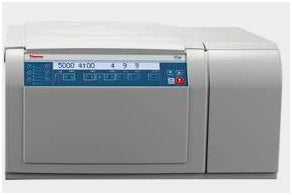
The Thermo Scientific Sorvall ST 16R refrigerated centrifuge is a general purpose centrifuge perfect for everyday sample processing, including clinical protocols, cell culture applications and microplate processing. This unit has a 4 x 400ml capacity with a maximum speed/RCF of 15,200rpm/25.830 x g. The refrigerated version is ideal for handling temperature-sensitive sample processing between -10° and +40°C.
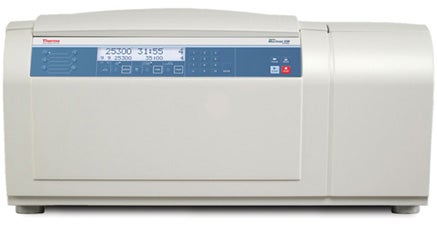
The Thermo Scientific Sorvall Legend X1R refrigerated centrifuge can handle a range of general-purpose processing including cell culture applications, microplate, bioproduction, blood separation, microbiology and others. This unit has a 1L capacity with a maximum speed/RCF of 15,200rpm/25.830 x g; ideal for handling temperature-sensitive sample processing between -10° and +40°C.
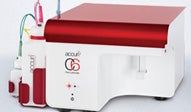
The BD Biosciences Accuri™ C6 is a personal flow cytometer is easy to use, simple to The system is equipped with a blue and a red laser, two light scatter detectors, and four fluorescence detectors with optical filters optimized for the detection of fluorochromes such as FITC, PE, PerCP, and APC. A compact optical design, fixed alignment, and pre-optimized detector settings make the system easier to use.

The Luminex 100 is a compact lab analysis system based on the principles of flow cytometry which enables the simultaneous assay of up to 100 analytes in a single well of a microtiter plate with very small volumes. This system delivers fast and cost-effective bioassay results on many assay formats including nucleic-acid assays, receptor-ligand assays, immunoassays and enzymatic assays.
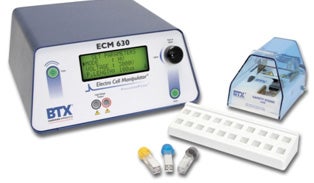
The BTX ECM 630 Electroporator is ideal for gram positive and gram negative bacteria, yeast, fungi and other microorganism transformation in HV mode, optimized for a broad range of mammalian cell lines in LV mode. Applications include, yeast, insect cells, bacteria, cDNA libraries, BAC library; novel applications include transdermal drug/gene delivery and intact plant gene delivery.
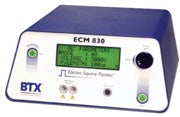
The ECM 830 is a Square Wave Pulse generator designed for in vitro and in vivo applications. The versatility of the ECM 830 applications for gene, drug and protein delivery include; mammalian cells, in vivo, ex vivo tissue, zebra fish tissue and embryos, nuclear transfer, embryo manipulation, plant protoplast and basic bacteria and yeast transformations. The ECM 830 can be used in combination with a wide array of BTX specialty electrodes and accessories to enhance your molecular and drug delivery experiments.

The Nucleofector™ Device is the single cuvette based system that has been used in research labs since 2001. It allows efficient transfection of hard-to-transfect cell lines and primary cells with different substrates (e.g., DNA vectors or siRNA oligonucleotides) in low-throughput format. The Nucleofector™ II/2b Device can also be used for bacteria transformation.
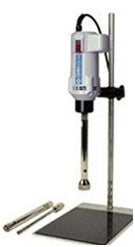
The OMNI General Laboratory Homogenizer is a powerful versatile and durable homogenizer that can handle virtually any processing application. It has a high powered motor that can handle even the toughest tissue samples, and emulsion and dispersions are quickly and easily completed. The OMNI GLH is compatible with stainless steel probes, has a processing range from 200µL to 10L, and can be hand-held or mounted for lengthier processing applications.
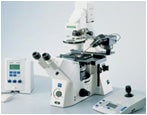
The Eppendorf InjectMan® NI 2 Micromanipulator has a menu-controlled, programmable micromanipulator, the InjectMan NI 21 is especially suitable for microinjection into adherent cells. The electronic connection of the InjectMan NI 2 and the FemtoJet®2 or FemtoJet express ensures a very rapid and safe microinjection. The semiautomatic microinjection allows a coordinated process of manipulation and injection: first, the injection parameter is set on the FemtoJet; second, the injection level is fixed via pressing a button on the InjectMan NI 2. The exact axial injection movement ensures a minimum mortality rate, and its high speed facilitates the penetration of rigid structures.

The NuAire DH AutoFlow Tissue Culture CO2 incubator uses a microprocessor based, non-dispersive infrared CO2 sensor to maintain a very accurate CO2 control is delivered within the incubation chamber.
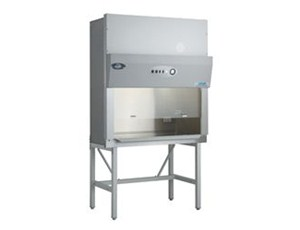
The NuAire Class II, Type A2 Biological Safety Cabinet is personnel and product protection reducing the potential for exposure to airborne biological or particulate chemical agents in low to moderate risk-hazard research and drug preparations. The cabinet’s airflow is 30% exhausted / 70% re-circulated to minimize cross-contamination. The BioSaftey Cabinet controls include a minihelic pressure gauge, motor voltage regulator, audible window alarm, main and outlet power circuit breakers, and power switches for exterior mounted fluorescent lights , interior outlets, and blower motor.
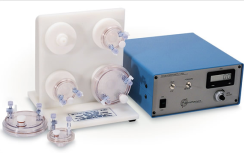
The Rotary Cell Culture System from Synthecon is unique system that provides a low turbulence, low shear culture environment for 3-dimensional cell and tissue structures. Biological structures are suspended in a rotating vessel, providing a dynamic, yet gentle environment that promotes the mass transfer of nutrients and molecular compounds throughout the cell population.
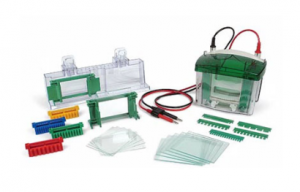
The BioRad Mini-PROTEAN® cell is ideal for vertical mini gel electrophoresis. This electrophoresis cell accommodates one or two handcast gels. The Mini-PROTEAN has a casting frame that ensures precise alignment easily accessible side by side casting stand with spring loaded lever tight seal. This system allows for the flexibility of handcast gels traditional SDS-PAGE, Electrophoretic mobility shift assays and Zymography.
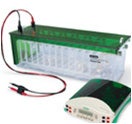
The BioRad Criterion Dodeca cell has the capacity to run up to 12 handcast of Criterion precast gels simultaneously or 11cm ReadyStrip IPG strips to give the optimal combination of separation and speed in 2-D electrophoretic applications.
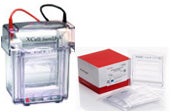
The XCell SureLock™ Mini-Cell Electrophoresis NuPAGE Novex System from Invitrogen is one of the systems available in the lab for electrophoresis. XCell lines of mini-cells are easy to assemble, sturdy and convenient. Currently we have 10 XCell tanks and they are utilized with NuPage precast polyacrylamide gels available cast with 10 or 15 wells, in 1.0mm or 1.5 mm thickness. These 4-12% gels are optimized with a neutral pH that minimizes protein modifications making them ideal for sequencing, mass spectrometry or other analysis where protein integrity is crucial.

The iBlot® 7-Minute Blotting System efficiently and reliably blots proteins from polyacrylamide gels in 7 minutes or less without the need for additional buffers or an external power supply. A self-contained unit, the iBlot® device uses disposable blotting stacks with integrated nitrocellulose or PVDF membranes offering the convenience of a bufferless, plug-and-play system.
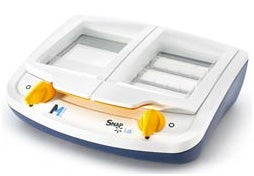
Millipore SNAP I.D Protein Detection System allows researchers to produce high quality western Blots 80% more quickly than conventional immunodetection protocols due to a vacuum-driven technology and built-in flow distributor that drives reagents through membranes and ensures even distribution. This unit is compatible with all membrane types and detection methods, such chemiluminescence and fluorescence.
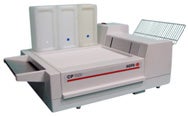
The AGFA CP1000 Automatic Film Processor is a compact and lightweight film processor ideal for low-volume processing. The processor has a fast start up and is easy to maintain. With its simple and accessible film transport system and an infrared dryer instead of a typical hot-air dryer, the system has an efficient short film processing time.
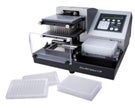
The BioTek ELx405R 96-well Plate washer is designed for applications from basic ELISA to cell and bead washing. This unit features an overfill protection, unique fluid/flow detection, crosswise aspiration and a built-in positive displacement pump. It has easy to use software provides up to 75 programs, up to 10 cycles/wash and control of dispense height. Aspiration height and delay, soak, shake, aspiration rate and horizontal aspirate and dispense position.
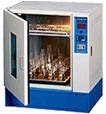
The GYROMAX™ 787 and 787R orbital incubators have a working temperature range from 5°C above ambient to 70°C and the shaker rotates at speeds from 25 to 400 RPM – digitally set. Each incubator chamber includes both a shaking platform that can accommodate a variety of different size flasks up to liters. Each chamber also has a shelf allowing both plates and rotating cultures to incubate simultaneously.
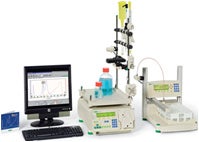
The BioRad BioLogic LP low-pressure chromatography is used for biomolecule purification. The system includes both 254 nm and 280 nm filters for nucleic acid and protein detection, and a conductivity cell to monitor gradient progress. The BioLogic houses a peristaltic pump with a flow rate range of 0.05-40 ml/min and a maximum backpressure of 30 psi. The system is compatible with Econo-Column low pressure chromatography columns and low-pressure chromatography media. Tme can collect into eighty 13 x 100 mm tubes or microtubes using a fraction collector. LP Data View software captures data, multitasks, and prints data. Further the system stores up to 50 methods, each method can include 50 pump steps and 50 fraction collection steps.

The BioRad PROTEAN IEF system is designed for isoelectric focusing (IEF) proteins in immobilized pH gradient (IPG) strips for the first dimension of two-dimensional (2-D) electrophoresis. The PROTEAN i12 IEF cell can run 1–12 IPG strips in 7, 11, 13, 17, 18, or 24 cm focusing trays. Each channel in the isoelectric focusing tray is independently powered, enabling precise control over each IPG strip.

The Thermoscientific Hybridization Oven has a 10-bottle capacity rotisserie with an accurate and uniform temperature control and uniformity. Temperature Range from 8 to 85 °C, temperature uniformity within bottle is ±0.25 °C and rotisserie speed from 5 to 15 rpm.

The ThermoMix 500 is a digitally controlled Peltier heater and cooler (6C – 105 C) orbital mixer (300-1500 rpm) for cell killing assays, RNA transcription, immunoprecipitation, enzyme kinetics, ligations, and more. Five interchangeable sample blocks are available for plates and different size tubes.

The Fisher Scientific Accuspin 17R is a high-speed refrigerated micro-centrifuge with a capacity of 48ml (24 x 1.5ml or 2.0ml microcentrifuge tubes, a maximum speed force of 13, 300 rpm/17,000x G, an easy-to-uses controls and digital display, an adjustable 99-min timer and quick-spin feature for short runs.
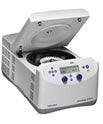
The Eppendorf 5430R Refrigerated Centrifuge is a unique cross-over bringing multipurpose and potential versatility to every lab bench with spin rotors for microcentrifuge tubes and PCR strips. Additional rotors can accommodate microplates as well as 15ml and 50 ml conical tubes. This unit is equipped with a programmable pre-cooling time, ECO shut-off function and assures accurate temperature control.

The ALC PM140 is a refrigerated centrifuge equipped with a swinging bucket rotor with interchangeable buckets addressing different tube sizes. This unit is ideal for large volume sample processing (48 x 15ml conical, 24 x 50ml conical), has two braking rates, a 30 minute timer and hold.
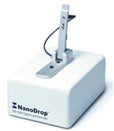
The Nanodrop ND-1000 is sample retention system designed to measure small volume samples of nucleic acids and proteins without the use of cuvettes or capillaries. Absorbance is captured and measured in a sample column made between two optical pedestals, displayed on an easy to read software interface, collected in an exportable spreadsheet and stored within the computer’s hard-drive. Measures DNA, RNA (A260) and Protein (A280) concentrations and sample purity (260/280 ratio); Large concentration range (2 ng/µL – 15,000 ng/µL dsDNA) without dilutions. Nanodrop software is pre-configured methods for common applications such as Nucleic Acid, Protein A280, Microarray, Proteins & Labels, Bradford, BCA, Lowry and Pierce 660nm
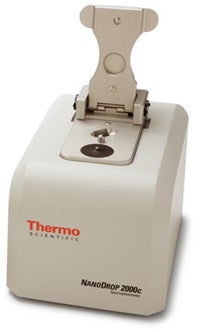
The NanoDrop 2000C is a spectrophotometer that combines microvolume pedestal technology and cuvette capability. The NanoDrop 2000C is a complete UV-Vis spectrophotometer preconfigured for all common nucleic acid and protein concentration and purity measurements, can measure very low and high concentration samples (0.4-15,000 ng/ μl and with samples as small as 0.5 µL . Cuvette capability allows for kinetics (time or time/ temperature) and cell culture (OD600) measurements. Cuvette position also includes temperature control (37 ºC) and stirring.

The GeneQuant is a small, compact spectrophotometer, It has been designed to measure absorbance at 230, 260, 280, 320, 546, 562, 595 and 600 nm, It can determine the concentration of the sample in a variety of units. The GeneQuant is able to measure 1 μl samples without dilutions of cuvettes allowing the sample to be recovered. This machine can be utilized for measuring absorbance of DNA, RNA, dyes, proteins and microbial cell culture OD.

The Eppendorf Vacufuge is a concentrator available for the efficient and gentle concentration of samples like RNA/DNA and proteins. The system is equipped with a vapor condenser purifying 85% of the exhaust. Two stackable 48-sample rotors are available allowing for the concentration of 96 samples at one time.
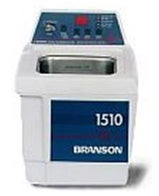
The Branson Tabletop Ultrasonic Cleaner provides a safe and consistent method of cleaning electronics and machine parts when soaking and steaming are insufficient. Touch panel allows for the easy setting and monitoring of cleaning cycles up to 99 minutes at 80 °C
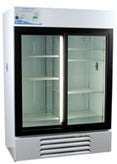
The Isotemp Plus Lab Refrigerator was designed for chromatography needs, with two capped access portholes to permit the insertion of thermocouples or other wiring without disturbing the temperature settings. Pushbutton lights and circuit breaker-protected electrical receptacles simplify equipment operation and allow observation of ongoing separations. Unit features microprocessor-controlled thermostats, a digital temperature display and a working temperature range from 1°C to 12°C.
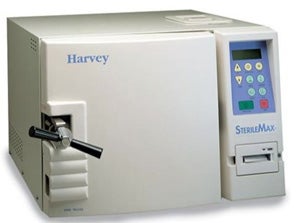
The Harvey SterileMax is a benchtop sterilizer features a 12” diameter x 18” deep (1.2 cu.ft.) sterilization chamber. This sterilizer is easy to set up – by simply adding water, plugging it in and choosing from 4 pre-set cycles, the system is ready to go. This unit also has three safety locks ensuring the chamber will not open until it has depressurized.
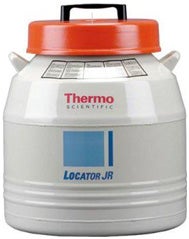
The Thermo Scientific Locator JR Cryo preservation tank is designed with a double-walled, vacuum insulated, narrow mouthed neck to minimize liquid nitrogen loss; maintains temperature uniformity at below -180° with less that 5cm remaining in vessel. Four stainless steel racks, each holding 1-1/4 square boxes, are arranged in numbered slots for easy retrieval; giving the Locator JR the capacity to hold 1600 vials.
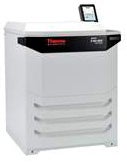
The Thermo Scientific Sorvall LYNX super-speed refrigerated centrifuge designed to run 24,000rpm/68,905 xg performance with the maximized capacity of 4 liters for bottles, tubes or microplates. This set up with two Fiberlite carbon fiber rotors, has shorter run-times, increased security and safety features. This system has an intuitive touch-screen control, can hold up to 99 programs and has user access control and password protection to accommodate a range of users.

The MicroCal VP-ITC is an ultrasensitive isothermal calorimeter designed to operate through a software interface to minimize operator involvement and facilitate quick, accurate analyses, while eliminating the need for thermodynamic expertise. The capabilities of the isothermal calorimetry as a technique in combination with VP-ITC can be utilized in applications that include the characterization of molecular interaction of small molecules, proteins, antibodies, nucleic acids, biomolecules and lipids and the assessment of the effect that changes in molecular structure has on binding mechanisms and the associated impact on biological activity.
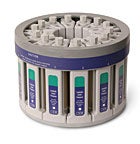
Perform up to 14 reactions simultaneously with CEM’sGreen Chem™ vessels. These 100-mL vessels are available with either PFA Teflon or glass liners.
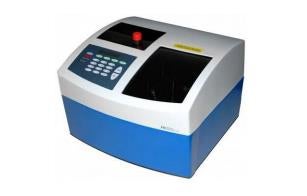
The compact and versatile Barocycler NEP2320 fills an important need for all laboratories that want improved sample preparation in genomics, proteomics, transcriptomics, and metabolomics. The NEP2320 is a safe and versatile sample preparation instrument designed to use a minimum amount of laboratory bench space, while still providing…the Power of PCT. The mechanisms of action of the PCT SPS differ significantly from other sample preparation methods. Specifically, lysis occurs when samples are subjected to alternating cycles of ambient and high pressure, up to 35,000 psi (45 kpsi Option Available), in the hydrostatic reaction chamber of the Barocycler. The NEP2320 uses available laboratory compressed air, bottled compressed air, or a standalone compressor to create high and ultra-high hydrostatic pressure inside the Barocycler reaction chamber. Exquisite control of the PCT process is accomplished by specialized components, a programmable controller, and software. The NEP2320 quickly and efficiently processes one sample at a time. Although smaller than the NEP3229, the NEP2320 still provides the user with many of the features of the Barocycler NEP3229, including temperature control.
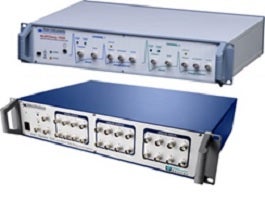
The Electrophysiology Measurement System is located in the Integrated Nanomaterials Laboratory, room 2112 of the Environmental Research Building on the Boise State campus. It consists of the MultiClamp 700B amplifier and the Digidata 1550 digitizer. The MultiClamp 700B is a computer controlled microelectrode amplifier designed for patch voltage- or current- clamp measurements of single ion channels, whole-cell voltage- and current-clamp recordings, intracellular electrode recordings, extracellular field potential recordings in an ion channel, neuroscience, nanopore and voltammetry studies. It is interfaced with a Digidata 1550 low-noise, high-resolution 16-bit data acquisition system for digitizing electrophysiology recordings. The two systems are controlled via pCLAMP 10.4 electrophysiology data acquisition & analysis software. If you would like more information regarding this equipment, please contact Dr. David Estrada, Assistant Professor of Materials Science & Engineering at daveestrada@boisestate.edu or (208) 426-5693.
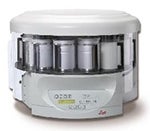
The Leica TP1020 Benchtop autoembedder is a benchtop tissue processor designed to provide gentle dehydration, clearing and infiltration of various tissues with paraffin wax. The TP1020 is completely programmable, allowing tissue-specific programs to be developed. A programmable, optional vacuum setting is available to improve infiltration.
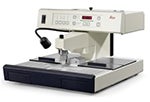
The Leica EG1150H is a heated paraffin dispensing module with a large heated work surface and storage areas for both cassettes and molds. The embedding module aids in obtaining proper orientation of tissues and final embedding in blocks of paraffin for sectioning.
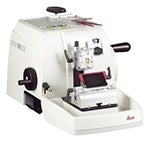
The Leica RM2235 Rotary Microtome is designed for precision manual sectioning of paraffin embedded tissues. The BRC has a knife holder for low profile blades, and a separate knife holder for high profile blades, used for sectioning harder materials. This microtome has a sectioning range of 1-60 mm.
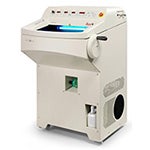
The Leica CM1950 cryostat is available for safe, accurate and fast high quality sectioning. The cryostat can section frozen tissues up to 100 microns in thickness.
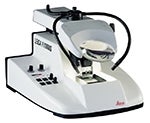
The Leica Vibratome VT1000 is allows sectioning of fresh or fixed tissue with or without embedding in support media such as agarose. Speed, frequency, amplitude, and clearance angle are all easily adjustable, and sections can be cut up to 999 microns.
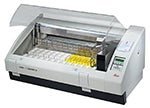
The Leica Autostainer XL provides a gentle method of staining multiple slides. This system is currently set up to quickly and easily stain tissues with hematoxylin and eosin and/or to simply dewax slides cut from paraffin blocks. The processor has the capability to automate multiple staining protocols, with up to 15 programs of 25 steps each.
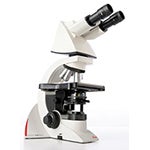
The Leica DM 1000 LED transmitted light microscope features long-life LED illumination that provides near daylight, bright illumination with constant color temperature. This is an extremely versatile microscope system, and can be optionally equipped for dark field, phase contrast, polarization contrast, and fluorescence. The microscope is fitted with a third generation SPOT TM RT3 Slider camera, which allows the user to capture both true color imaging and high sensitivity monochrome images.
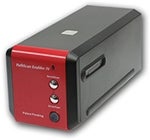
The PathScan Enabler IV Slide Scanner is designed to allow the scanning of an entire whole-mounted histology sample attached to a standard 1 x 3 inch cover-slipped glass slide. This allows for the production of low power, large field of view, high resolution imaging. Pathscan produces image files that can be saved in a variety of formats including TIFF and JPEG.

The Leica Stellaris 5 confocal system is configured with a Leica DMi8 inverted microscope and the following options: Objectives: 5x/0.15 HC PL FLUOTAR; 20x/0.75 HC PL APO, 25x/0.95 W HC FLUOTAR, 40x/1.10 W HC PL APO, 63x/1.4 Oil HC PL APO. Scan Head: four HyD internal detector channels. Laser Lines: 405nm, 488nm, 552nm, and 638nm. Software: LAS X Lightning Expert.
Please contact Dr. Keller-Peck at 208-426-2254 or by email at ckpeck@boisestate.edu for more information.
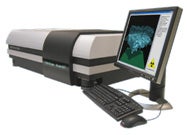
The BRC’s SkyScan 1172 High resolution X-ray Micro-CT Scanner utilized for scanning high-density tissues such as bones to low-density softer tissue such as lung. The Skyscan 1172 with dynamically variable acquisition geometry provides the shortest scan times possible at any magnification and cross-section images are generated in a wide range of formats up to 8000 x 8000 pixels. 2D/3D reconstruction can be performed using a single PC or using the 4-PC cluster in the BRC facility to enhance post-scan reconstructions times.

The THUNDER Imager Model Organism fluorescence stereo microscope combines a large field of view with high image quality for thick samples. Z-scans through the entire volume of a fish or other small organism is possible due to the removal of out-of-focus signal with instant computational clearing and adaptive deconvolution. Illumination Source: Leica LED3. >3000mW white light output; 390-680nm wavelength range. Filter Sets: DAPI, GFP, mCherry, and CY5. Camera: DFC9000GT sCMOS monochrome. 4.2 MP chip; 2048-2048 pixels, 6.5×6.5 µm pixel size.
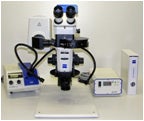
The Zeiss StemiSV11M2 Bio Quad Fluorescent Microscope is designed in collaboration with Kramer Scientific, M2 Bio Quad uniquely combines stereo macro and compound micro imaging capabilities in one microscope. This ability to combine the ergonomics of stereo observation and high-resolution microscopic observation in a single microscope offers enormous improvements in time management in the exploding field of studying fluorescent proteins of GFP, YFP, BFP and its new counterparts. Now you can sort larger populations in stereoscopic mode and simply pivot the objective system into position for high-magnification detailed observation.
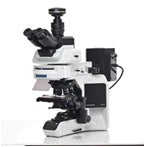
The Olympus America’s BX53 is a compound microscope with an automated mechanical stage, camera, computer interface, digital display, fine focus, and image analysis software and oil immersion lens. Samples can be viewed by brightfield, phase contrast and under polarizing light. Objective magnification from 1.25x to 40X.
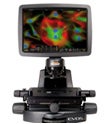
AMG EVOS Fluorescence microscope is an easy to use fully integrated inverted multichannel LED fluorescent microscope capable of screening slides stained with DAPI, green and red fluorescence along with phase contrast imaging. Software includes tools for overlaying images and counting. The EVOS microscope has a manual stage with many adapters allowing slides, multi-well wells, 100mm and 35tmm dishes and flasks to be easily observed and imaged.
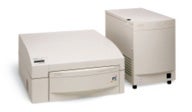
The BioRad Pro Fluorescent Phospho-Imager is optimally suited for the field of proteomics, this fluorescence scanner has 50-μm resolution and a 5 order of magnitude linear dynamic range is capable of single or multicolor fluorescent scanning, can accommodate large gels and images are integrated with PDQuest 2-D Analysis Software. Internal and external lasers allow this unit to perform digital autoradiography by scanning phosphor plates or performing corresponding tissue fluorescence imaging by directly scanning thin tissue sections.

The Kodak Imager 4000R imaging system has cooled CCD imaging technology, 4-million pixel resolution, true 16-bit imaging producing 65,000 levels of grayscale resolution for accurate intensity measurement. Detection capabilities include absorbance, chemiluminescence and UV fluorescence imaging.

The Luminex 100 is a compact lab analysis system based on the principles of flow cytometry which enables the simultaneous assay of up to 100 analytes in a single well of a microtiter plate with very small volumes. This system delivers fast and cost-effective bioassay results on many assay formats including nucleic-acid assays, receptor-ligand assays, immunoassays and enzymatic assays.

The SynergyMx is a flexible and easy to use monochromator-based multi-mode microplate reader with fluorescence, absorbance and luminescence detections modes. The monochromatic optics can select any UV-Visible wavelength in 1nm increments.
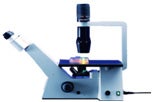
The Zeiss Axiovert 40CFL for transmitted light, Phase contrast, DIC and fluorescence, fixed camera port connected to Zeiss ERc5S Zeiss digital camera, equipped with 5X, 10X, 20X and 40X objectives and filters for common blue and green fluorescence.
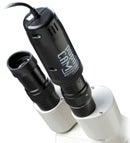
The Pupil Cam is an easy-to-use digital microscope camera with a built-in 10x eyepiece that gets placed directly on the ocular tube of the most standard microscopes. High resolution images can capture full screen microscopic images. These images can then be manipulated within the software. Pre-attached USB or Video cables make for easy attachment to your computer or monitor.
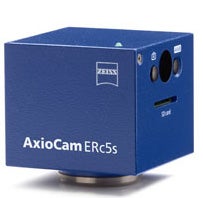
The AxioCam ERc 5s microscope camera can be operated via AxioVision in the conventional way, but it also works as a stand-alone imaging station. Neither a PC nor any software are required in order to acquire images of your samples. This ZEISS camera acquires color images with 5 megapixels and stores them on memory cards in the economical and widely used SD format. The AxioCam ERc 5s is operated simply via two easily accessible buttons: one triggers the acquisition of the image, while the other performs the automatic white balance. If you subsequently wish to transfer your images to a PC, all you need to do is insert the SD card into the memory card slot on your PC.

The Pentax Optio W80 is an ultra durable shock resistant waterproof camera up to depths of 16 feet in water where it can take underwater video. It is also resistant to temperatures of -10ºC so is well suited for taking images in the field. While only an inch thin, it has a 12.1 megapixel sensor with a 5X optical, Super Macro mode which brings details in from even the smallest and closest subjects (as close as 1cm).
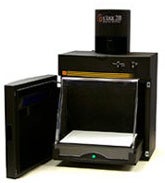
The Gel Logic 200 system features great imaging capacity. A UV transilluminator, and protective UV shield, makes visualization and excision of bands from ethidium bromide and other fluorescent dyes, simple and safe. White light illumination capability with a UV conversion screen and while light epi-illumination for visualization of samples labeled with chromogenic labels. This unit is equipped with real time viewing for sample positioning and adjustments and a mega-pixel scientific grade CCD sensor that captures crisp detailed images increasing the quantitative accuracy of analyses.
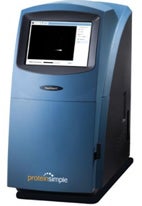
The FluorChem E Digital Darkroom is designed for high-performance western blot and gel imaging able to detect chemiluminescent, colorimetric and UV fluorescent gels and blots. It includes a state-of-the-art CCD optical technology with simplified touch screen allowing users to select settings, capture images, save and print images all from one screen.
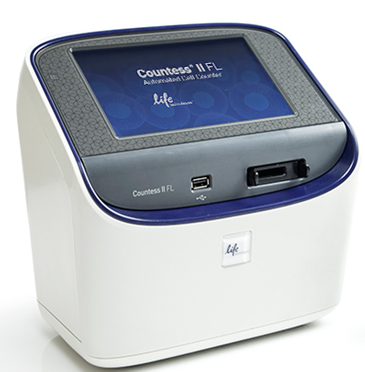
The new Countess® II FL Automated Cell Counter is a benchtop cell assay platform equipped with state-of-the-art optics and image analysis software for rapid assessment of cells in suspension. Now with fluorescence capabilities—bright-field and two optional fluorescence channels—researchers can count cells, monitor fluorescent protein expression, and measure cell viability.
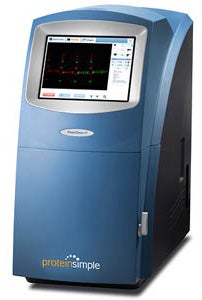
The FluorChem R is a simple to use and multifaceted Imaging Station designed with an integrated computer, intuitive touch-screen and outfitted with state-of-the-art CCD optical technology. This system has the capability to image data from multiplex, chemiluminescent, and colorimetric western blots as well as from UV fluorescent DNA and protein gels. Post-capture image optimization and analysis can be performed via a web browser accessible from image station, PC, MAC, tablet or smartphone.
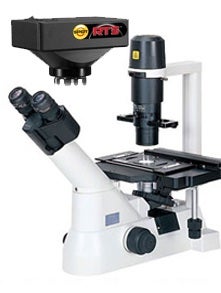
The TS100 inverted microscope & SPOT RT3 Camera. The microscope utilizes a high-intensity LED eco-illumination system reducing eyestrain for users and eliminates color temperature changes that occur with halogen light sources. The SPOT RT3 microscope camera is easy to use, able to capture both color or monochrome images, and excellent for both brightfield and fluorescence imaging.
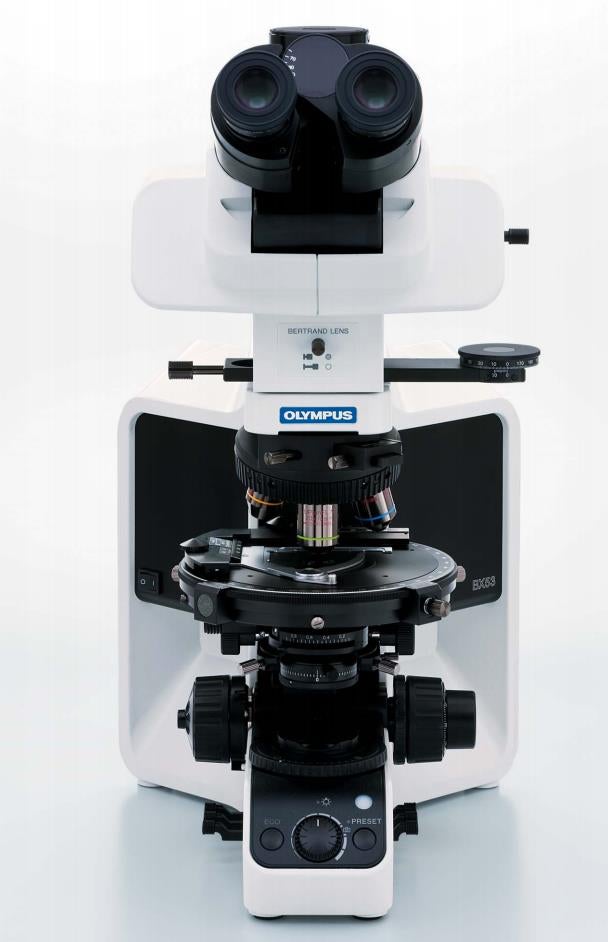
The Olympus BX53-P Polarizing Microscope performs superbly in polarized light. It’s a breakthrough combination of UIS2 infinity-corrected optics and Olympus original optical-design. Olympus has also devised a new, extended line of compensators to make the BX53-P versatile enough to handle observation and measuring applications in virtually any field. Thanks to Olympus’ sophisticated design and manufacturing technology, the ACHN-P and UPLFLN-P objectives reduce internal strain. BX3 polarizing microscope features high EFvalue filters in polarizer and analyzer resulting in unmatched image contrast. To meet a diversity of research and application requirements, the universal UPLFLN-P series objectives have been designed to accommodate a wide range of observation methods, including Nomarski DIC and fluorescence microscopy, in addition to polarized light observation.
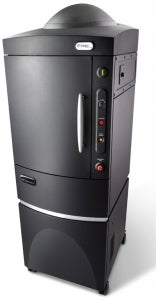
An IVIS® Spectrum is available for optical imaging technology of mice to facilitate non-invasive longitudinal monitoring of disease progression. A Skyscan 1172 High Resolution X-ray Micro-CT Scanner is also available for bone analysis.

The StatSpin CytoFuge provides a simple solution to preparing thin-layer cell preparations. Suspended cell suspensions are processed quickly onto a microscope slide with filter concentrators. Results are consistent, easy to scan monolayer cell presentations with morphologic detail. The Cytospin has six separate time cycles and speed settings from 600-4400 rpm.
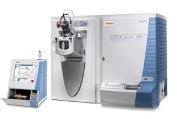
Themo Scientific Velos Pro LIT Mass Spectrometer is an ion trap mass spectrometer and it is located in the BRC, room 215 in the Mathematics Building at Boise State University . It offers Trap-HCD (Higher-Energy Collisional Dissociation) combined with CID (Collision-Induced Dissociation), and PQD (Pulsed-Q Dissociation) to enhance coverage and sensitivity of proteomic analysis. An Easy nL nano liquid chromatographic system is coupled to the mass spectrometer through the nanoelectrospray source for protein characterization. In combination with the Thermo Proteome Discover 1.3 and Sequest and Mascot database search engine, this LC-MS system is our work horse for routing proteomic analysis.
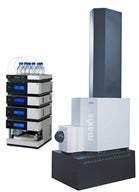
Bruker Q-TOF Mass Spectrometer is located in the mass spectrometer is located in the BRC, room 215 in the Mathematics Building on the campus of Boise State University. This system is a hybrid tandem mass spectrometer with outstanding performance including fast acquisition rate (up to 30 Hz for small molecules, up to 5Hz dynamic for peptides), high resolution (50,000 Full Sensitivity and Resolution), high resolution EIC (0.5 – 1mDa on typical LC peaks), and excellent sensitivity (1 pg Reserpine >100:1 S/N RMS). This mass spectrometer is coupled with a Dionex Ultimate 3000 HPLC system and an innovative Captive electrospray source. In combination with software tools, including Bruker Compass Data Analysis, Smartformula, ProteinScape, Mascot protein search engine, and Profile Analysis, we use this LC-MS system in small molecule identification, metabolomics analysis and protein characterization.
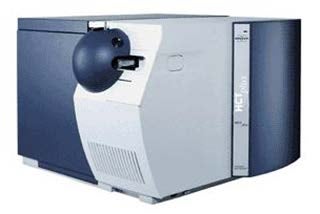
Bruker HCT Ion Trap Mass Spectrometer from Bruker Daltonics is located in the Analytical Lab, room 363 in the Science building on the Boise State University campus. The HCT is a robust and easy to use mass spectrometer. Coupled with an electrospray sources, it provides good MS and MS/MS spectra quality – in terms of mass resolution, sensitivity and accuracy throughout a wide mass range for applications like: Protein identification, metabolite characterization, and general chemistry LC/MSn. Equipped with an Electron-transfer dissociation (ETD) and CID, HCT provides unique capability to identify post translational modification of protein.
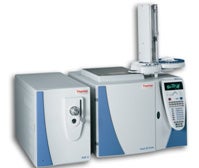
The Thermo Polaris Q GC/MSn Benchtop Ion Trap Mass Spectrometer complete with Thermo Trace Gas Chromatograph, external vacuum pump, and XCalibur PC workstation. This combination of power of the MS ion trap technology target specific compounds in complex matrices. The Polaris Q offers unparalleled sensitivity in full scan, plus the power of MS/MS, the PolarisQ provides dependable performance for routine application plus the added horsepower to go further enabling lower detection in complex matrices.
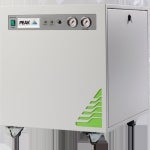
Utilizing Carbon Molecular Sieve and Pressure Swing Adsorption, the Genius 1050 provides on-site nitrogen for your LC-MS instrument. The Genius 1050 is well suited for a range of particularly demanding applications where specific performance specifications are required.
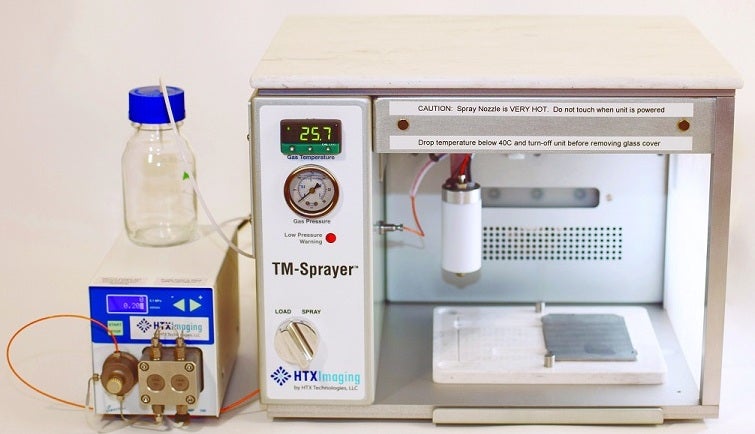
HTX Imaging’s patented TM-Sprayer™ Tissue MALDI Sample Preparation System is designed to provide the highest quality matrix deposition on the two-dimensional biological samples, and can be integrated with any MALDI Mass Spectrometer platform. Because the principle of MALDI MS is based on the introduction of a UV-activated matrix molecule in the immediate proximity of the analyte, it is imperative to control the process by which matrix is introduced in the sample. Unique in design, the TM-Sprayer provides heat to the matrix solution to accelerate adsorption into the tissue, as well as a controlled flow of dry air or nitrogen to focus the spray and control drying time.
Using the TM-Sprayer™ the matrix solution is both heated and pressurized, which gives the matrix spray several beneficial properties:
- The heated matrix is able to better penetrate the tissue surface and reach analytes.
- The faster rate of evaporation avoids the creation of large matrix crystals (often known to create hot spots).
- The pressurized spray is very directional, ensuring a precise location of the matrix deposition.

The Thermoscientific Hybridization Oven has a 10-bottle capacity rotisserie with an accurate and uniform temperature control and uniformity. Temperature Range from 8 to 85 °C, temperature uniformity within bottle is ±0.25 °C and rotisserie speed from 5 to 15 rpm.

The ThermoMix 500 is a digitally controlled Peltier heater and cooler (6C – 105 C) orbital mixer (300-1500 rpm) for cell killing assays, RNA transcription, immunoprecipitation, enzyme kinetics, ligations, and more. Five interchangeable sample blocks are available for plates and different size tubes.

The Nanodrop ND-1000 is sample retention system designed to measure small volume samples of nucleic acids and proteins without the use of cuvettes or capillaries. Absorbance is captured and measured in a sample column made between two optical pedestals, displayed on an easy to read software interface, collected in an exportable spreadsheet and stored within the computer’s hard-drive. Measures DNA, RNA (A260) and Protein (A280) concentrations and sample purity (260/280 ratio); Large concentration range (2 ng/µL – 15,000 ng/µL dsDNA) without dilutions. Nanodrop software is pre-configured methods for common applications such as Nucleic Acid, Protein A280, Microarray, Proteins & Labels, Bradford, BCA, Lowry and Pierce 660nm.
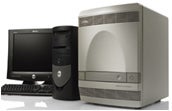
The ABI 7300 Real Time PCR System combines thermal cycling, fluorescence detection and application specific software to measure the cycle-by-cycle accumulation of PCR products in a single-tube reaction. The ABI utilizes a 96 well format supporting a volume range of 20-100 µl. Four-color detection provides the flexibility to perform a variety of applications which include gene expression analysis, pathogen quantification and SNP genotyping. Software includes plate setup wizard, advanced data viewing, sorting and graphing capabilities with quantitative results that are available immediately upon completion of PCR.
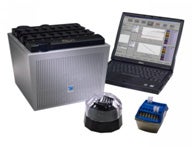
The Smart Cycler Real Time PCR machine from Cepheid utilizes the I-CORE module of microfluidic and microelectronic design. Each Smart Cycler processing block contains 16 independently programmable I-CORE modules, each of which performs four-color, real-time fluorometric detection. A variety of simplex or multiplex fluorescent tags can ne used in conjunction with this system including FAM, TET< ALEXA 532m ALEXA 748, TAM, ROX, SYBE Green, Cy3, Texas Red and others.
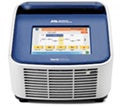
The Veriti Thermal Cycler from Applied Biosystems has six independent temperature blocks which adds increased flexibility and precision ideal for PCR optimization and the comprehensive gene amplification. The Veriti has an easy touch screen user interface. The GeneAmp 2720Thermal Cycler, also from Applied Biosystems, is designed for a full range of PCR and cycle sequencing applications. Both the Veriti and the GeneAmp 2720 thermal cycler units are equipped with a 96-well format compatible with standard 0.2ml PCR tubes and 96 well reaction plates.
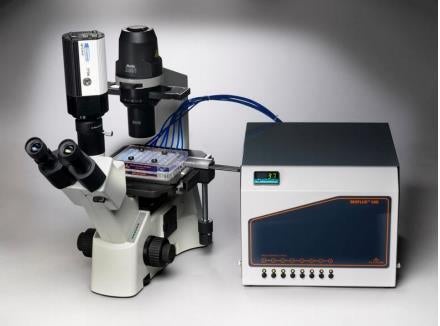
The BioFlux System gives you the ability to introduce flow to your research and drug discovery experiments effectively emulating in vivo conditions and getting closer to understanding what’s happening under more physiological conditions. Offering the physiological relevance of laminar flow chambers with the throughput and convenience of standard well plates, BioFlux systems have many features and benefits including:
- High Speed: With automated experimental control, multiplexing up to 96 simultaneous experiments, and sophisticated data analysis software simplifying and accelerating complex functional assays, large projects can be effectively reduced from months to days.
- High Quality: Glass bottom plates with superior image quality from microscopes and high content imagers provide unparalleled image quality.
- Simple to Use: Well plate microfluidic design improves reliability and reproducibility while enabling precise control of critical parameters.
- Modular Design: A BioFlux system can be added to any existing inverted microscope setup instantly expanding its capabilities.
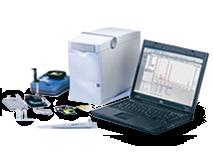
The Agilent 2100 Bioanalyzer system provides sizing, quantitation and quality control of DNA, RNA, proteins and cells on a single platform, providing high quality digital data.
- Two assay principles – electrophoresis and flow cytometry
- Ready-to-use assays and pre-packaged reagent kits
- Minimal sample consumption (1-4 µL)
- Easy to use – load the chip, press “start“, the instrument does the rest!
- Digital data for convenient analysis, archiving and storage
- Contamination-free switch of methods
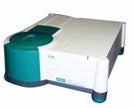
The Varian Cary 50 UV/VIS Spectrophotometer has a data collection rate of 80 points per second that can be optimally utilized to acquire information for kinetics assays. This unit features a maximum scan rate of 24, 000 nm per minute and a scan range for 190-1100 that can be completed in less than 3 seconds. The use of a Xenon lamp which flashes only when acquiring a data point minimizes the degradation of photosensitive samples, and as the Xenon lamp is intense, a beam splitter can be used with the loss in energy and allows for simultaneous beam correction.

Reichert SR7000 Surface Plasmon Resonance spectrometer is designed for label-free, real-time detection of molecular interactions with nano to micro to macro applications. This instrument monitors surface plasmon resonance (SPR) and offers critical angle capability, and monitors response versus reflectivity data. This Reichart SPR has a high thermal conductivity, works in a temperature range of 10 °C to 90 °C, is easily programmable and can has kinetic capability over a broad temperature range. This system has been automated with the addition of a Themofinnagen Surveyor Auto Sampler and Pump.
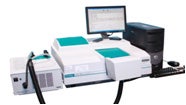
The Varian Cary UV-Vis Spectrophotometer is an instrument that utilizes the visible and UV portion (190 nm to ~900nm) of the electromagnetic spectrum to monitor the electronic transitions of molecules as the monitoring of absorption peaks can be correlated with the types of bonds and valuable in determining the functional groups within a molecule. This spectrophotometer is equipped with a Petlier-thermostatted mulitcell sample transport, a temperature controller, an extended sample compartment, Cary UVWin Bio software, and includes a variety of modules: Simple and Advanced Reads module, Concentration and Kinetics modules, Enzyme and Scanning modules, and RNA/DNA and renaturation modules, a self-contained unit which drives Peltier heating in the thermostable accessory which is attached and regulated by a built-in radiator with circulating water.
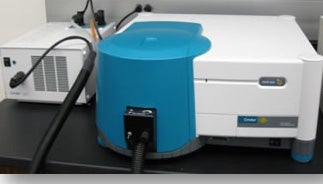
The Cary Eclipse Fluorescence Spectrophotometer uses a Xenon flash lamp for superior sensitivity, high signal-to-noise, and fast kinetics. It measures the emission of light from samples in four modes. Using Xenon lamp technology, it captures a data point every 12.5 ms and scans at 24,000 nm/min without peak shifts. The Cary Eclipse is the only spectrophotometer with room light immunity. With an optional microplate reader, it offers full wavelength scanning of 384 samples.

The Biotek SynergyMx is a flexible and easy to use monochromator-based multi-mode microplate reader with fluorescence, absorbance and luminescence detections modes. The monochromatic optics can select any UV-Visible wavelength in 1nm increments.
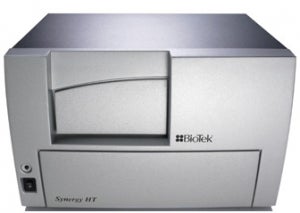
The BioTek Synergy™ HT Multi-Mode Microplate reader designed with a dual optics design for fluorescence, absorbance and luminescence measurements. With a tungsten halogen lamp, this unit provides constant intensity, increased sensitivity and repeatability. This system has the ability to use filters with different bandpasses which allows the investigator to tailor their fluorescence measurements to their experiment more effectively.
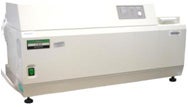
The Jasco J-810 spectropolarimeter is a hybrid instrument consisting of a variable wavelength polarimeter and absorption spectrophotometer. It is designed to allow secondary structure determination by circular dichroism; specifically measuring the left-and right-handed circularly polarized light of optically active molecules. It is equipped with a thermoelectric type temperature control system and flo-through HPLC cell. The instrument is controlled by Jasco’s Spectra Manager software.
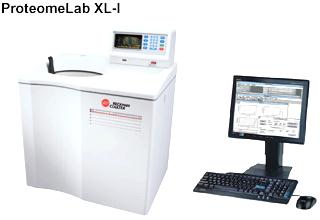
The ProteomeLab/XL-I analytical ultracentrifuge measures the relative change in the distribution of molecular weights, providing an efficient way to measure heterogeneity, stoichiometry, and self-associating systems. It is designed for the in-solution characterization of proteins, oligomers, aggregates, particles, colloids, and small structures. The wide range of rotational velocities also allows investigators to probe protein size, dimerization, and binding constants. Sedimentation velocity experiments are utilized to determine protein molecular weight and identify degree of dimerization and sedimentation equilibrium experiments are utilized to determine binding constants.

The ABI 7300 Real Time PCR System combines thermal cycling, fluorescence detection and application specific software to measure the cycle-by-cycle accumulation of PCR products in a single-tube reaction. The ABI utilizes a 96 well format supporting a volume range of 20-100 µl. Four-color detection provides the flexibility to perform a variety of applications which include gene expression analysis, pathogen quantification and SNP genotyping. Software includes plate setup wizard, advanced data viewing, sorting and graphing capabilities with quantitative results that are available immediately upon completion of PCR.

The Smart Cycler Real Time PCR machine from Cepheid utilizes the I-CORE module of microfluidic and microelectronic design. Each Smart Cycler processing block contains 16 independently programmable I-CORE modules, each of which performs four-color, real-time fluorometric detection. A variety of simplex or multiplex fluorescent tags can ne used in conjunction with this system including FAM, TET< ALEXA 532m ALEXA 748, TAM, ROX, SYBE Green, Cy3, Texas Red and others.

The Veriti Thermal Cycler from Applied Biosystems has six independent temperature blocks which adds increased flexibility and precision ideal for PCR optimization and the comprehensive gene amplification. The Veriti has an easy touch screen user interface. The Veriti is a thermal cycler is equipped with a 96-well format compatible with standard 0.2ml PCR tubes and 96 well reaction plates.
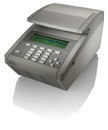
The GeneAmp 2720Thermal Cycler, also from Applied Biosystems, is designed for a full range of PCR and cycle sequencing applications. The GeneAmp 2720 is a thermal cycler is equipped with a 96-well format compatible with standard 0.2ml PCR tubes and 96 well reaction plates.
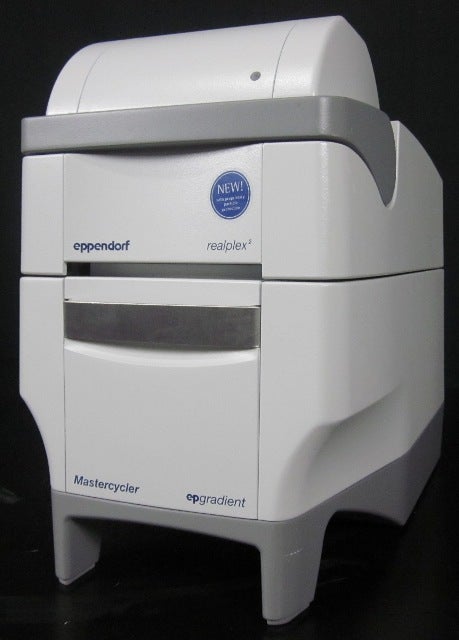
The Mastercycler ep realplex is designed to meet all the requirements of quantitative PCR applications which includes extremely fast temperature ramping, short detection times and intuitive assay programming translate to huge time-savings so that more experiments can completed per day-always with accurate and reliable results. It′s flexibility is beyond compare-this completely open system allows you to use tubes, plates and reagents of your choice. No other real-time cycler on the market today offers such freedom.

The Roche’s Light Cycler 96 utilizes leading-edge fixed fiber optics to provide simultaneous and therefore unbiased real-time data capture from one, and up to four, channels. This light cycler was designed with both four excitation and four emission filters, with a 10-50μl reaction volume, to accommodate a sample format of an 8-tube strip or 96 well plates and with detection formats that include intercalating dyes and hydrolysis probes.

The TS100 inverted microscope & SPOT RT3 Camera. The microscope utilizes a high-intensity LED eco-illumination system reducing eyestrain for users and eliminates color temperature changes that occur with halogen light sources. The SPOT RT3 microscope camera is easy to use, able to capture both color or monochrome images, and excellent for both brightfield and fluorescence imaging.

The new Countess® II FL Automated Cell Counter is a benchtop cell assay platform equipped with state-of-the-art optics and image analysis software for rapid assessment of cells in suspension. Now with fluorescence capabilities—bright-field and two optional fluorescence channels—researchers can count cells, monitor fluorescent protein expression, and measure cell viability.
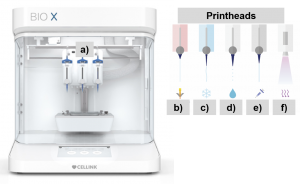
The BioX bioprinter by CELLINK is capable of fabricating tissue culture constructs containing any type of live cell which enables the production of any tissue target found in the body and can also be used to study drug delivery studies.
- Printheads and toolheads: a) Temperature-controlled printhead, b) Thermoplastic printhead, c) standard pneumatic printhead, d) Electromagnetic droplet (EMD) printhead, e) Syringe pump printhead, and f) Photocuring toolhead.
- Exchangeable photocuring modules: 365 nm and 405 nm.
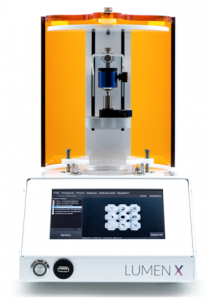
The LumenX by CELLINK uses digital light processing (DLP) printing to offer users high resolution, high throughput and high fidelity which enhances applications in microfluidics, cell-laden hydrogels, microporous structures and more.
- Image projector: 405 nm visible blue light.
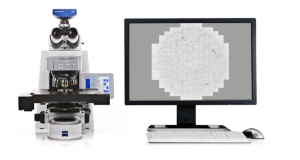
The Zeiss Axio Imager microscope produces crisp images and high optical performance particular to sophisticated contrasting techniques such as Circular Differential Interface Contrast (C-DIC). Axiocam 105 color camera attachment.
- Objective lenses: 5X, 10X, 20X, 50X and 100X.
- Contrasting techniques: Brightfield, Darkfield and C-DIC.
- Zeiss Colibri LED system: can use up to six LED modules to generate up to seven fluorescent excitation lines which each produce monochromatic light of a different wavelength. It allows for fast and gentle live cell images with seven colors, multicolor imagining with high frame rates, fast multicolor tile imaging, 2D and 3D imaging with Apotome.2, FRET imaging or other dual-excitation imaging applications, quantitative imaging in cell physiology or immunohistochemistry and 3D widefield imaging and deconvolution.
- Excitation bands: 385/30 nm, 423/44 nm, 469/38 nm, 511/44 nm, 555/30 nm, 590/27 nm, 631/33 nm and 735/40 nm.